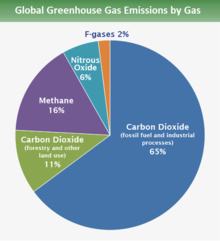User:Aderush/Greenhouse gas emissions
| This is the sandbox page where you will draft your initial Wikipedia contribution.
If you're starting a new article, you can develop it here until it's ready to go live. If you're working on improvements to an existing article, copy only one section at a time of the article to this sandbox to work on, and be sure to use an edit summary linking to the article you copied from. Do not copy over the entire article. You can find additional instructions here. Remember to save your work regularly using the "Publish page" button. (It just means 'save'; it will still be in the sandbox.) You can add bold formatting to your additions to differentiate them from existing content. |
Greenhouse gas emission from agriculture[edit]
Traditional rice cultivation is the second biggest agricultural methane source after livestock, with a near-term warming impact equivalent to the carbon-dioxide emissions from all aviation. Government involvement in agricultural policy is limited due to high demand for agricultural products like corn, wheat, and milk. United States Agency for International Development's (USAID) global hunger and food security initiative, Feed the Future project is addressing food loss and waste. By addressing food loss and waste greenhouse gas emission mitigation is also addressed. From only focusing on dairy systems of 20 value chains in 12 countries food loss and waste could be reduced by 4-10%. These numbers are impactful and would mitigate greenhouse gas emissions while still feeding the population.



More specifically, carbon dioxide, nitrous oxide, and methane are the biggest greenhouse gases emitted from agriculture[1]. Methane emissions come from livestock such as cows respiring and are the number one contributor to greenhouse gases globally. Every year one cow alone will emit 220 pounds of methane methane making 14.5 % of greenhouse gas emissions[2]. While the residence time of methane is much shorter than that of carbon dioxide its potency is 28 times stronger its contribution to warming[2]. Not only does livestock contribute to harmful emissions but they also require a lot of land and may overgraze which leads to unhealthy soil quality and reduced species diversity[2]. A few ways to reduce methane emissions includes consumption of plant-rich diets with less meat, feeding the cattle more nutritious food, manure management, and composting[3].
Nitrous oxide emission comes from the increased use of synthetic and organic fertilizers. Fertilizers increase crop yield production and allows the crops to grow at a faster rate. Agriculture emissions of nitrous oxide is 6% of the greenhouse gas emission in the United States and has increased in concentration by 30% since 1980 [4]. While 6% may appear to be a small contributor, per pound nitrous oxide is 300 times more powerful than carbon dioxide emissions and has a residence time of around 120 years[4]. Different management practice such as water conservation through drip irrigation, nutrient monitoring to avoid overfertilization, and the use of a cover crop in place of fertilizer application may help in reducing level of nitrous oxide emissions[5].

Carbon dioxide emissions come from things such as tilling of fields, planting of crops, and even the shipment of crops or food cultivated to markets for revenue[6]. Agricultural related emissions of carbon dioxide account for around 24% of the global greenhouse gas emissions[7]. To help mitigate carbon dioxide emissions farm practices such as reduce tillage, decrease in empty land, return biomass residue of crop to soil, and increase use of cover crops can be promoted [8].

- ^ Smith, Laurence G.; Kirk, Guy J. D.; Jones, Philip J.; Williams, Adrian G. (2019-10-22). "The greenhouse gas impacts of converting food production in England and Wales to organic methods". Nature Communications. 10: 4641. doi:10.1038/s41467-019-12622-7. ISSN 2041-1723. PMC 6805889. PMID 31641128.
- ^ a b c Quinton, Amy (June 27, 2019). "Cows and climate change".
- ^ "Curbing methane emissions: How five industries can counter a major climate threat | McKinsey". www.mckinsey.com. Retrieved 2022-04-04.
- ^ a b "The Greenhouse Gas No One's Talking About: Nitrous Oxide on Farms, Explained". Civil Eats. 2019-09-19. Retrieved 2022-04-04.
- ^ Resources, University of California, Division of Agriculture and Natural. "Nitrous Oxide Emissions". ucanr.edu. Retrieved 2022-04-04.
{{cite web}}: CS1 maint: multiple names: authors list (link) - ^ "Agricultural Practices Producing and Reducing Greenhouse Gas Emissions" (PDF).
{{cite web}}: line feed character in|title=at position 23 (help) - ^ US EPA, OAR (2015-12-29). "Sources of Greenhouse Gas Emissions". www.epa.gov. Retrieved 2022-04-04.
- ^ Food, Ministry of Agriculture and. "Reducing agricultural greenhouse gases - Province of British Columbia". www2.gov.bc.ca. Retrieved 2022-04-04.
